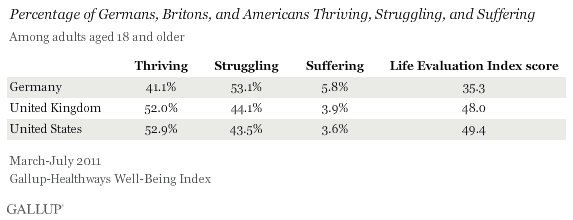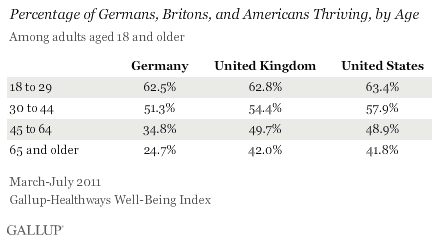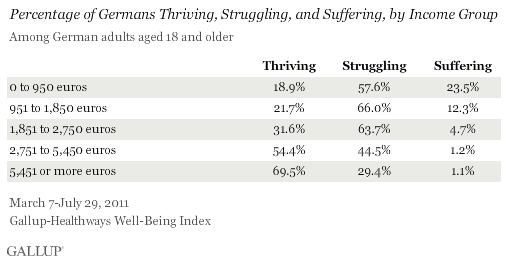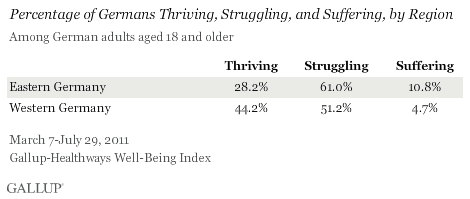BERLIN -- Germans rate their lives worse on average than do adults living in the U.K. and the U.S., according to the inaugural findings from the Germany Gallup-Healthways Well-Being Index. Less than half, 41.1%, of Germans rate their current lives and expectations for their lives in five years high enough to be classified as "thriving," compared with 52% of Britons and 52.9% of Americans who say the same. Relatively few Germans are "suffering," but a majority are "struggling."

Gallup classifies respondents' well-being as thriving, struggling, or suffering according to how they rate their current and future lives on a ladder scale with steps numbered from 0 to 10 based on the Cantril Self-Anchoring Striving Scale. People are considered thriving if they rate their current lives a 7 or higher and expectations for their lives in five years an 8 or higher. People who rate their current or future lives a "4" or lower are classified as suffering. All others are considered struggling.
This Life Evaluation Index is a key component of the Gallup-Healthways Well-Being Index, which provides a comprehensive monthly measure of Germans' physical, emotional, and financial health. The overall Life Evaluation Index score is calculated by subtracting the percentage of suffering Germans from the percentage of thriving Germans. Germany's Life Evaluation Index score of 35.3 is significantly lower than in the U.K. (48) and the U.S. (49.4).
Older Germans' Life Ratings Trail U.S. and U.K. Ratings the Most
Middle-aged and older Germans rate their lives far worse than their younger counterparts and their peers in the U.S. and the U.K. While the percentage considered thriving decreases with age in all three countries, it does so much more sharply in Germany. More than half of Germans aged 18 to 29 (62.5%) and those aged 30 to 44 (51.3%) are thriving, similar to the rates in the U.S. and U.K. At the same time, 34.8% of Germans aged 45 to 64 and 24.7% of Germans 65 and older are thriving, compared with percentages higher than 40% in the U.K. and U.S.

High-Income Germans More Likely to Be Thriving
High-income Germans are significantly more likely to be thriving than their low-income counterparts. Less than 20% of Germans at the lowest monthly household income level -- 950 euros or less per month -- are thriving, compared with 69.5% of Germans in the highest household income category.

Life Evaluation Ratings Lower in Eastern Germany
More than two decades after reunification, life appears to remain distinctly different for Germans living in the East than it is for those living in the West. In the Western part of the country, 44.2% of Germans are thriving, compared with 28.2% living in eastern Germany -- a 16 percentage point difference.

Differing economic conditions are likely a major contributing factor in these regional differences. Unemployment in eastern Germany is significantly higher than what it is in the Western half of the country. Average incomes in the East also continue to trail incomes in the West. Given the close relationship between income and life evaluation in Germany, Easterners' comparatively worse financial situation -- tied closely with their higher unemployment -- is likely a key contributor to their lower life ratings.
Implications
The German Bundestag in late 2010 put in place a special parliamentary Enquete Commission on "Growth, Wealth and Quality of Life," and tasked it with developing ways to measure societal well-being as a complement to more traditional measures like GDP. The Gallup-Healthways Well-Being Index, initiated in Germany in March of this year, is currently doing this.
The Well-Being Index will provide a comprehensive measure of Germans' well-being, and with 1,000 surveys per month, can reveal meaningful demographic, socio-economic, and regional differences among the country's residents. Gallup's comparable well-being ratings in the U.S. and U.K. provide helpful benchmarks for interpreting the well-being results from Germany. For example, Germans' low Life Evaluation Index score compared with the U.K. and U.S. scores -- nations with somewhat similar GDP per capita -- reveals that Germans are dissatisfied with certain aspects of their lives beyond how much money they have. This finding also underscores previous Gallup global research, which has found that many factors -- in addition to income -- including health, education, and governance relate to quality of life. This type of behavioral economic data is vital to helping government and business leaders predict and shape outcomes to improve the lives and economic situations of all Germans.
View all Gallup-Healthways Well-Being Index questions and methodology.
About the Gallup-Healthways Well-Being Index
The Gallup-Healthways Well-Being Index tracks well-being in the U.S., U.K., and Germany and provides best-in-class solutions for a healthier world. To learn more, please visit well-beingindex.com.
Survey Methods
Results are based on telephone interviews conducted as part of the Gallup-Healthways Well-Being Index survey March 7-July 29, 2011, with a random sample of 4,811 adults, aged 18 and older, living in Germany, selected using random-digit-dial sampling.
For results based on the total sample of national adults, one can say with 95% confidence that the maximum margin of sampling error is ±1.67 percentage points.
Interviews are conducted with respondents on landline telephones and cellular phones.
Samples are weighted by gender, age, education, region, adults in the household, and cell phone status. Demographic weighting targets are based on the most recently published data from the German Statistics Office. All reported margins of sampling error include the computed design effects for weighting and sample design.
In addition to sampling error, question wording and practical difficulties in conducting surveys can introduce error or bias into the findings of public opinion polls.
For more details on Gallup's polling methodology, visit www.gallup.com.
